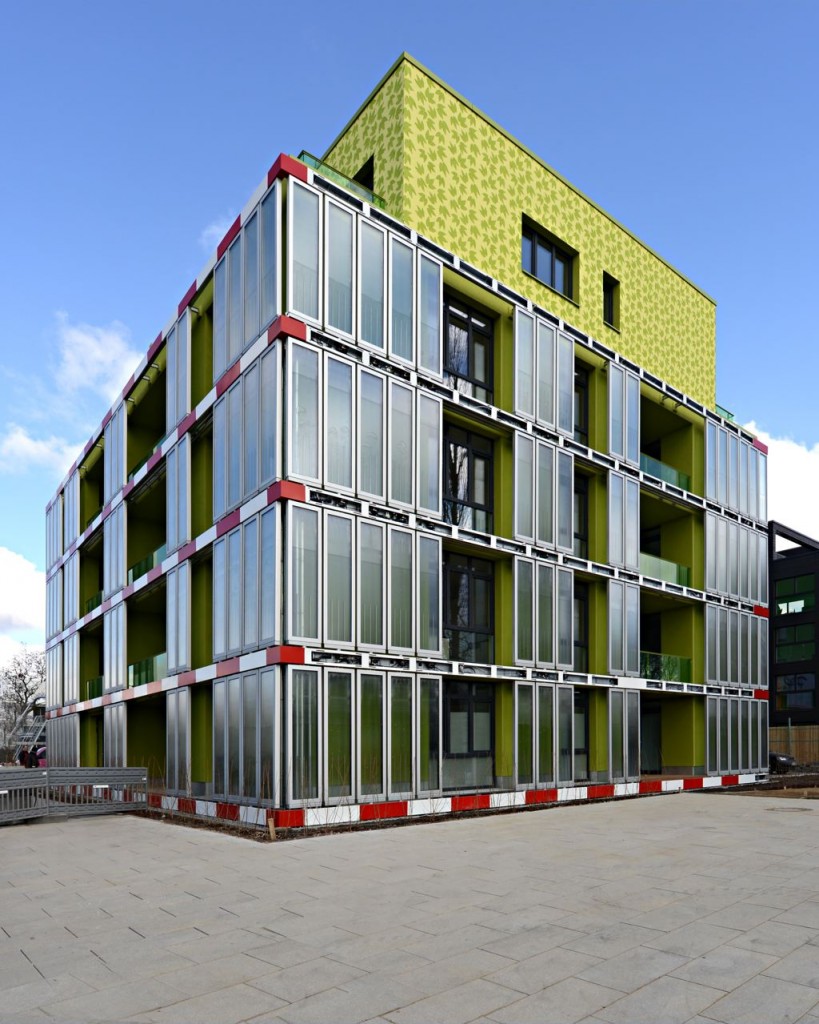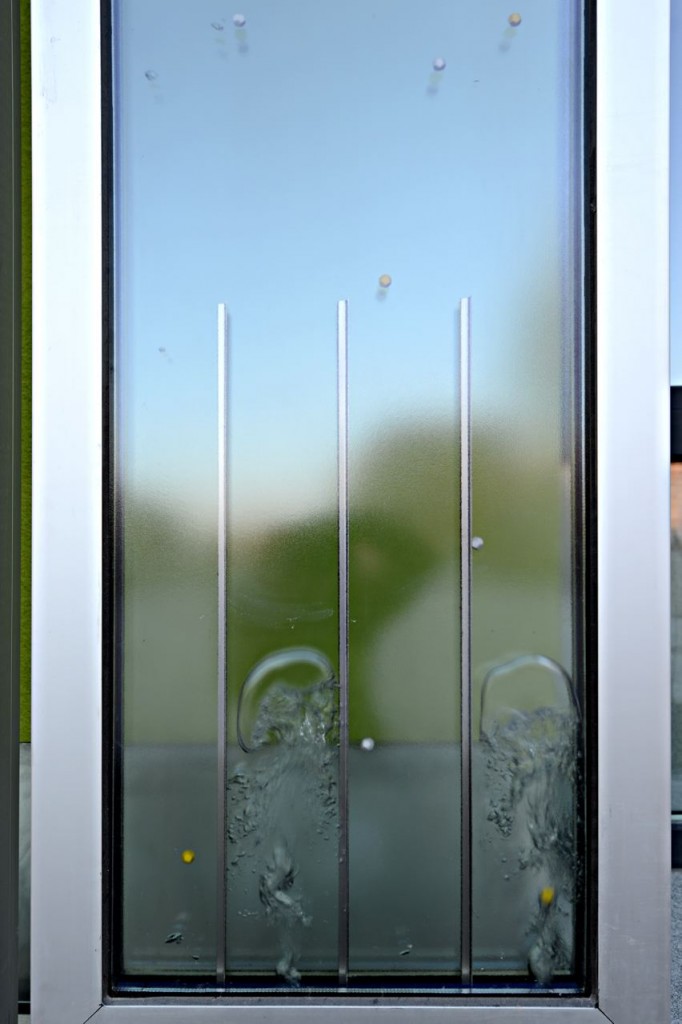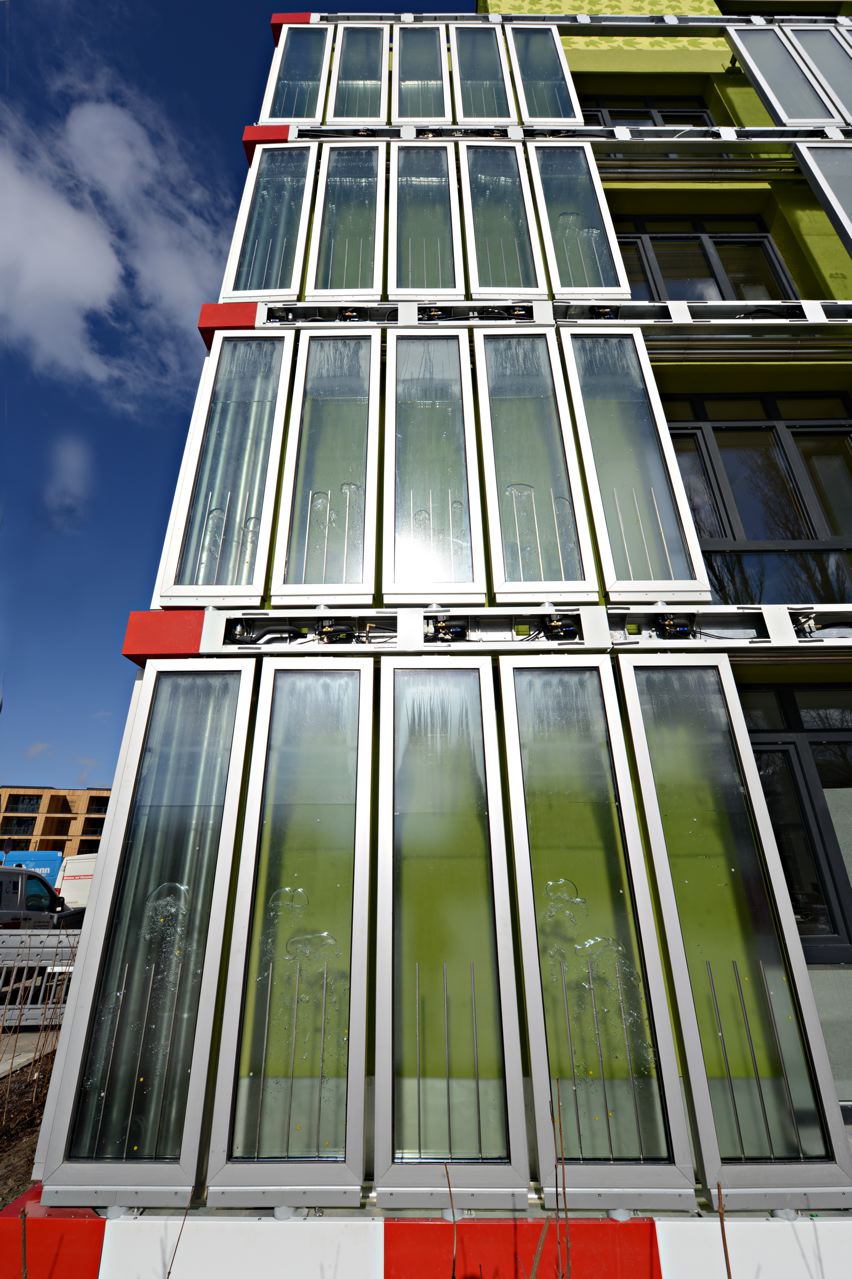
RODUCT OVERVIEW
Purpose of this product:
Bioreactor Façade – A dynamic façade system for the production of renewable energy using algal biomass and solar thermal heat. Building Integration:
The system is suitable for both new buildings and existing buildings, and for industrial, commercial,
existing buildings, and for industrial, commercial, residential and public buildings.
Features and benefits:
Full integration of low energy design for energy efficient buildings with a Passivhaus standard;
conversion of natural light to biomass and heat; local storage and use of solar thermal
energy; sustainable energy design – near to CO2 neutral; dynamic and adaptive shading, since
with the increasing intensity of solar radiation the transparency and the degree of total energy
transmission (g-value) decrease; living and dynamic user experience created by the emerging
air bubbles and the variations of colour of the SolarLeaf elements; also applicable as a primary
façade system with additional benefits in terms of high thermal and acoustic insulation.
SOLARLEAF – THE BIOREACTOR FAÇADE

The vertical glass louvres are filled with water containing nutrients which conver
daylight and CO2 to algal biomass through the bio-chemical process of photosynthesis
at the same time the water is heated up by solar-thermal effects. The biomass and
heat generated by the façade elements are transported by a closed loop system to the
plant room, where both forms of energy are exchanged by a separator and a heat
exchanger respectively. The temperature levels of the heat generated can be increased by
of the heat generated can be increased by using a hot water pump for the supply of hot
water and for heating the building. Excess heat can be stored by use of a geothermal system.
The biomass has high energy content, and can therefore not only be used for generating
energy but also processed and used by the food and pharmaceutical industries.
To be able to benefit from the synergies of the system, a holistic and comprehensive
design approach is required right from the beginning.
From 2020 onwards, zero-energy houses will be obligatory in Germany and in some
other European countries. Every new building will need to produce the same amount of
will need to produce the same amount of energy as it consumes. In 2012, the energy
generated by photovoltaic systems and solar thermal systems in Germany provided 1.5%
thermal systems in Germany provided 1.5% of the total energy supply, while biomass
as a renewable energy source provided 8%.
The advantage of biomass compared to photovoltaic is that it is a form of solar energy
that can be easily stored and therefore doesn’t require expensive storage technologies
like batteries. The bioreactor façade is the first building integrated system to generate
biomass.
The conversion of light to heat is a well first building integrated system to generate
design. In contrast, the conversion of light to biomass is a biochemical process facilitated by
microscopically small algae, called microalgae.
Microalgae, like other higher level plants, use sunlight for the photosynthetic process and
this is linked to the process of conversion of much more efficient in the conversion of light
to biomass than higher-level plants, because they consist only of single cells, each of whic
is capable of photosynthesis. Microalgae can divide themselves up to two times a day and
thus increase their biomass by a factor of four.
Their biomass contains 23-27 kJ of energy per gram dry weight. This biomass can be used as
raw material for cosmetic and pharmaceutical products or is used for animal food or dietary
supplements. By varying the cell density in the culture medium the transparency can be
varied between 10 and 80%

HOW DOES SOLARLEAF WORK?
When used as a secondary façade the bioreactor elements form a rainscreen system
of the outer layer of a double-skin façade. The vertical elements have a size of 2.5m x 0.7m
and can span across a full storey if required. In addition they can rotate along its vertical axis
to track the position of the sun. When fully closed the SolarLeaf forms a continuous outer
skin providing a thermal buffer.
Each SolarLeaf element features a multiple glass assembly, designed to meet the latest
performance criteria of modern façade engineering. The two inner layers form an
18mm wide cavity with a capacity of 24 litres for the circulation of water and growth of
algae. For safety and thermal insulation the photobioreactor is clad on both sides with
laminated safety glass.
Compressed air is introduced to the bottom of each bioreactor at certain time
intervals. The gas emerges as large air bubbles and generates an upstream water flow and
turbulence to stimulate the intake of CO2 and light by the algae. At the same time, the
inner surfaces of the panels are washed by to the naked eye. The flat photobioreactors
are thus very efficient for algal growth and need minimal maintenance. All servicing pipes
for the inflow and outflow of the culture medium and the air are integrated into the
substructure of the SolarLeaf elements. At the BIQ pilot project in Hamburg 32 elements
are combined into a closed loop system and
connected to the plant room.
A central building management system controls all the processes necessary to
operate the bioreactor façade and to fully integrate it with the energy management
system of the building. This includes the control of the algal cell density and the
temperature in the culture medium.
The heat obtained from the façade has a temperature of about 40°C and is either
used directly to heat water or is stored in the ground by use of a geothermal system. The
system can be operated all year long.
The efficiency of the conversion of light to biomass is 10% and to heat 38%. For
comparison, photovoltaic systems have an efficiency of 12-15% and solar thermal
systems 60-65%.
So the bioreactor façade is competitive relative to these other technologies. In
addition, bioreactor façades remove CO2 from flue gas at quantities equivalent to th
build-up of biomass and thus reduce the CO2 emissions from buildings and help to improve
the overall CO2 balance.

“The “SolarLeaf ”
bioreactor façade is
pointing the way ahead
for the future of the
façade and low energy
engineering for Green
Buildings”
SOLARLEAF in OVERVIEW
A Solarleaf bioreactor façade:
– produces high value biomass (10% ECS*)
– produces solar thermal heat (38% ECS*)
– provides dynamic shading
– increases the thermal and acoustic
performance
Optimal conditions for building integration:
– Production of a constant flue gas or source
of carbon
– Production of heat throughout the year
– Ideal for south facing façades (>200 m²)
* ECS = energy conversion efficiency ratio, which indicates the percentage of the incoming light
energy converted to biomass or heat.
